Читать книгу Raphael - Eugène Müntz - Страница 2
На сайте Литреса книга снята с продажи.
Biography
Оглавление1483: Raffaello Santi or Sanzio, known as Raphael, is born in Urbino, probably on the 6th of April. He is the son of Giovanni Santi, a painter and official poet at the court of the great patron of the arts Federico da Montefeltro.
1491: Death of Raphael’s mother. He is deeply affected by the event.
1494: His father also dies. He is taken in by his uncle, a priest.
1495: The young artist arrives in Perugia and supposedly becomes one of the disciples of Pietro Vannucci, known as Perugino.
1501: The artist finishes the first work known to be his, the altar of the church of San Nicola da Tolentino, at Castello, in Umbria.
1504–1508: He spends several years in Florence, which is later known as his Florentine period. He discovers the works of Leonardo and Michelangelo, which influence him strongly. Raphael paints many pictures of the Virgin Mary, in particular The Madonna of the Goldfinch (1506), The Madonna of the Pinks (1506–1507) and The Madonna and Child with Infant St John the Baptist, often called La Belle Jardinière (1507–1508).
1508: He leaves for Rome where he settles permanently. Pope Julius II asks him to decorate the Stanze della Segnatura at the Vatican. They contain two major works: the School of Athens and Disputation over the Most Holy Sacrament.
1512: Raphael takes up architecture. He plans, designs, and supervises the construction of a chapel for Agostino Chigi.
1514: He finishes the decoration of another room in the Vatican, the Stanza dell’Eliodoro. The artist’s popularity is now such that he receives many commissions. Most are finished by his assistants, so much work does he have. His workload increases even more when he is asked to finish St Peter’s Basilica, following the death of his mentor and friend, the architect Bramante.
1515: Raphael paints the Portrait of Baldassare Castiglione, probably with the help of his assistants.
1516: Cardinal Giuliano de’ Medici commissions the altarpiece of the Transfiguration. He will work on it until his death and it will then be finished by one of his pupils.
1517: Raphael is appointed superintendent of antiquities in Rome by Pope Leo X. He immediately begins an inventory of the ancient monuments in the city.
Still working for the Pope, he completes a series of ten cartoons for tapestries for the Sistine Chapel. These are later woven by Pieter van Aelst in Brussels.
1518–1519: He paints one of his masterpieces, the Portrait of Leo × with Cardinals Giulio de’ Medici and Luigi de’ Rossi. It is perhaps his only late work done entirely without the help of his assistants.
The Fornarina is also painted during this period, inspired by the baker’s daughter with whom Raphael is supposed to have been hopelessly in love.
1520: Raphael dies of a fever on the 6th of April, his thirty-seventh birthday. As he is by then wealthy and admired, his funeral is held in the Vatican and his body buried in Rome at the Pantheon.
